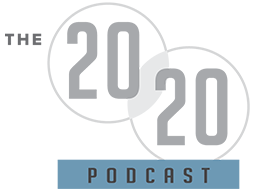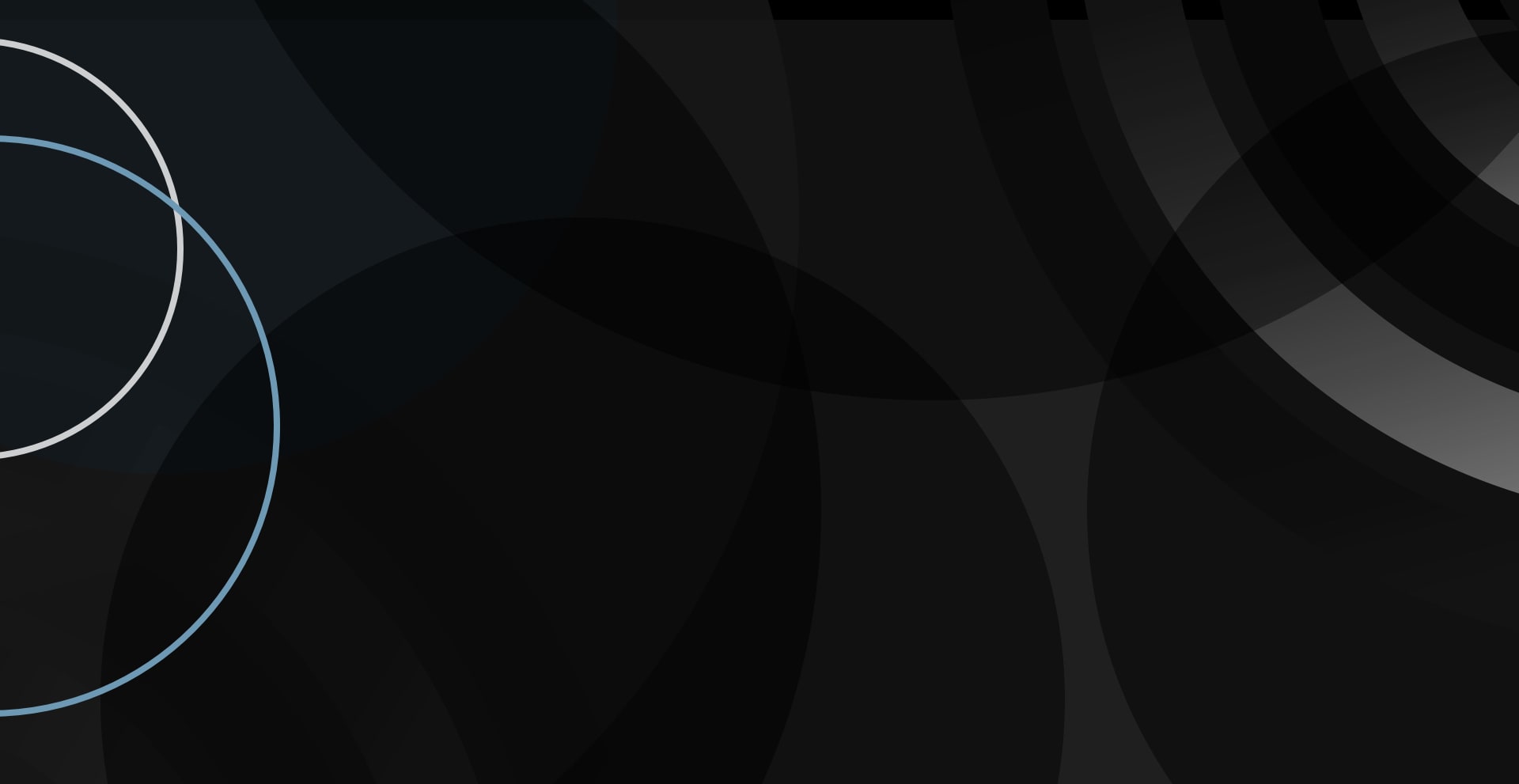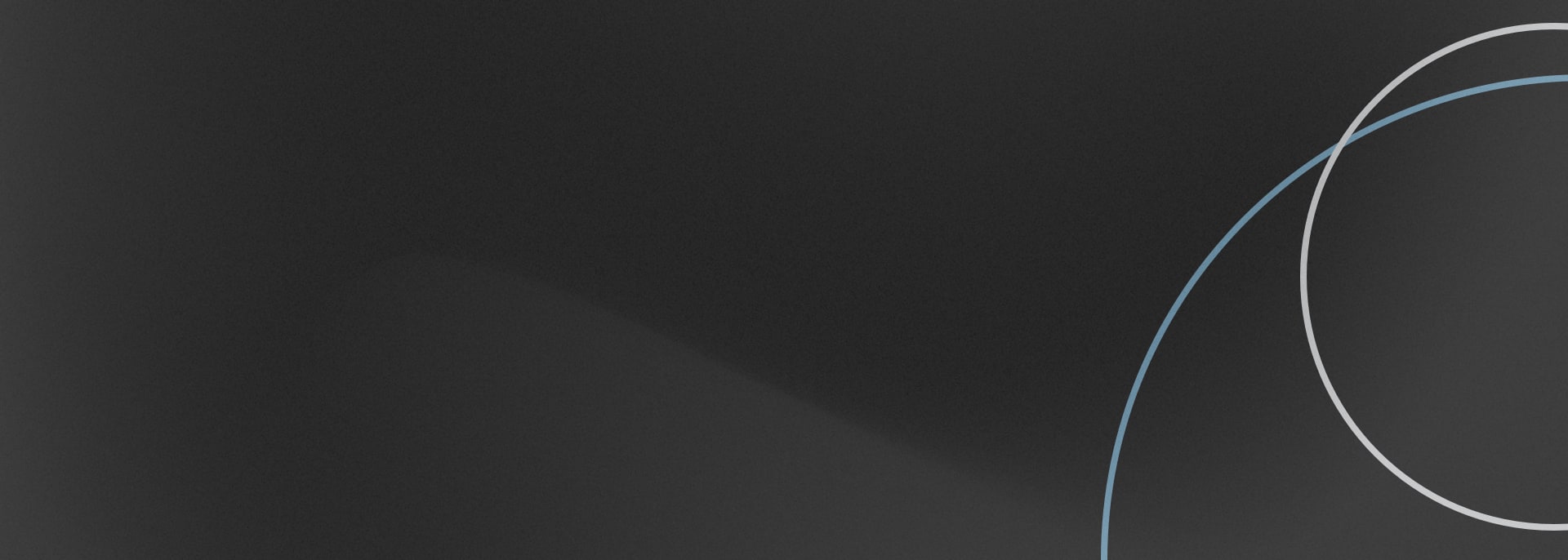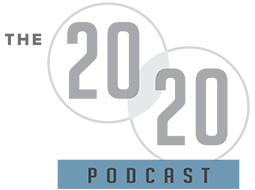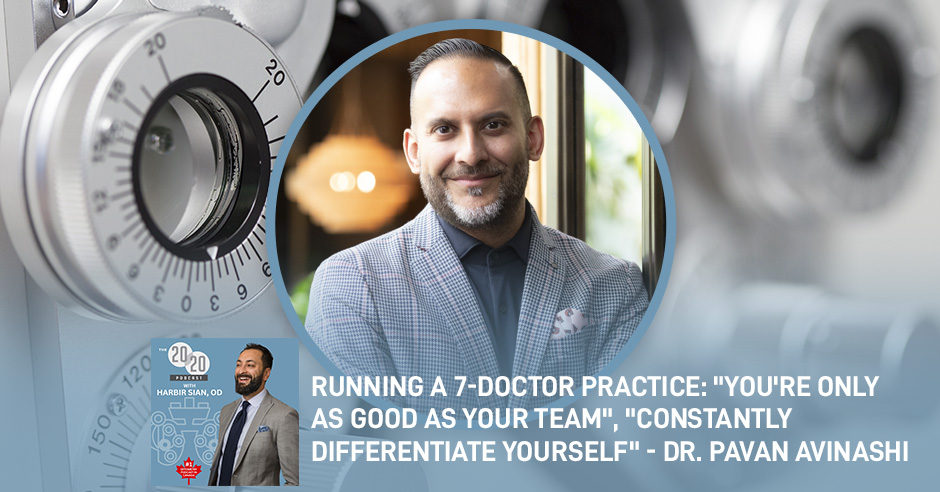
How comfortable are you recommending high end products to your patients? Whether its contact lenses, boutique frames, or ophthalmic lenses, recommending the best-in-class to patients has long been a challenge for many ECPs. But why? And, more importantly, how can we overcome this hurdle?
In this episode, I chat with Dr. Pavan Avinashi who is the owner of Hollyburn Eye Clinic in North Vancouver. Over the last 22 years, Dr. Avinashi has built Hollyburn into the type of clinic many ODs aspire to run: a 6-lane, modern practice with 7 ODs, a dedicated aesthetics spa, and a reputation for offering the best options in eyewear.
So, how did Dr. Avinashi build his practice to this level? Today, he shares his top three recommendations for business owners who aspire to offer the best to their patients.
Big thanks to Hoya Vision Care Canada for their support of this episode.
Learn more about Hoya and their premium lens offering:
https://www.hoyavision.com/en-ca/vision-products/
Connect with Harbir:
—
Watch the episode here
Listen to the podcast here
Running A 7-Doctor Practice: “You’re Only As Good As Your Team”, “Constantly Differentiate Yourself” – Dr. Pavan Avinashi
Welcome back to another episode of Canada’s number one optometry show. I am your host, Dr. Harbir Sian. Thank you so much for taking the time to join me here to learn and to grow. I always appreciate all the support. I’m always so grateful. Thank you for all the likes, the sharing, and everything else you do to help the show continue to grow. We are in the very beautiful JW Marriott Hotel in downtown Vancouver at the BC Doctors of Optometry Conference.
I want to say a huge thank you to BCDO for everything they do, and for continually putting on the best optometry conference in Canada. If you’re tuning in to any of these episodes that we record here, I’m saying this at the beginning of every one of them because I truly believe BCDO is doing such an amazing job to continue to help optometry thrive in BC, and hosting events like this does help. My mission with the show is always to bring on amazing guests who are going to help us grow personally and professionally. They are going to help the profession move forward. My man, Dr. Pavan Avinashi, is a beautiful example of that. He’s a returning guest. Is this your third time back on now?
I think so. I did episode number 2 or 3.
You were early on.
Now, what are you, 2002 episode? You have killed it.
Thanks. I appreciate that. Thanks to you because you were one of the first guests to give me the time of day, and let you come on the show when I had no idea what I was doing.
It’s because you gave me a free bottle of vodka. I was like, “I’m taking up my time.”
In case you don’t know, Dr. Avinashi is the owner of a very big, busy, beautiful, successful practice called Hollyburn Eye Clinic, which has grown to a seven-OD practice. He is a renowned speaker and consultant. He is all over the industry and has made a mark over the years. It’s always my pleasure to have you on. He also happens to be a good friend of mine. It’s always good to have you on. We’re going to be talking about how you built a practice, but where premium products, premium lenses in particular, have come in and helped you build that practice.
I also got to say a big thanks to our partner, HOYA Vision Care, for supporting this show and everything they do for optometry and for supporting me as well in my journey in our clinic and our profession. Let’s talk about Hollyburn. If you were to rewind the clock a little bit, when you were 25 years old, when you look back, what are some of the 2 or 3 key takeaways that you could share with us that you think have helped you build Hollyburn up to where it is now?
Core Pillars Of Practice Growth: Patient-Centric Service, Team Culture, & Differentiation
I was 25 years old when I started my practice. It’s been a journey. There is no doubt about it. Through it all, we all know the concept that we don’t get trained in business acumen in our schooling, but in the school of hard knocks. If I look back at the wins and the losses that have come, I have to narrow it down to 2 or 3 things that have allowed us to go to where we are. Number one, as cliche as it sounds, it is constantly going back to patient-centric service. We are healthcare providers, but when we’re independent and we’re trying to grow this, it is a customer service-based first.
That’s what I remind my patient and my staff. That’s what I remind my doctors and myself daily. We are there to serve to the best of our ability for each patient that walks in. I don’t care if I’ve been seeing Mrs. Jones for 22 years in a row. If I don’t make that last eye exam the best eye exam, the best experience, and the best overall, take-home good feeling at the end of that visit, I or my team probably have failed. That person may not come back to us next year. There are too many competitive options and too many channels to look at to find eye care providers. It is a patient-centric service. That’s what we focus on in team building.
Number two, you could be a great eye doctor, but you’re only as good as your team. If my staff don’t deliver the same caliber of professionalism, customer service, and respect to each patient, that patient will choose to go somewhere else. People will have more selections. They’re being more finicky about who their providers are. To help with that, we focus on building a team culture that creates retention, happiness in the workplace, and then growth as well. The second critical thing is to have that team culture.
You may hear this from a lot of your colleagues and from talking to a lot of doctors and ECPs out there. In this busy, competitive market, how do you stay a step ahead? You’ve got to constantly differentiate yourself. It is about differentiating yourself with diagnostics, with therapeutics, with service, and with the aesthetics. You can have a whole talk on how to differentiate practice. That’s the most important thing.
Developing A Strong Team Culture Through Respect
Patient-centric service, culture, and differentiation are the three big things that you think have helped. We’re going to talk a little bit about differentiation as we talk about premium products, premium sales, and things like how they help you differentiate as well. That’s amazing. I see that when I come to your practice. I can see the team culture and the way that everybody works in the practice. It all comes from you as the leader. As a leader, what do you start with if you’re trying to develop a strong culture in your clinic?
You’re only as good as your team. If your staff don’t deliver the same caliber of professionalism, customer service, and respect to each patient, that patient will choose to go elsewhere.
It comes down to respect. It is showing the staff members that it doesn’t matter if they are coming on as the newest staff at their first job, are being paid the lowest on the totem pole, and have no experience in the industry. Respect them as much as you do the staff member who’s been there with you for 22 years. Essentially, you have certifications or diplomas as an optometrist. You treat each staff member the same.
That’s what I want them to reciprocate with patient care as well. It doesn’t matter if we’re getting a CEO of a multi-billion dollar company as one of our patients that’s been loyal to us every year for the last 22 years, or a first-time patient that can’t afford much, that communication may be a gap, and respect may be an issue. We have to treat them the same way and give them the same caliber of service and care. That’s what I try to do with my staff as well.
Start with the respect. I love that. Hollyburn is an independent private practice. How has being independent been valuable or important in your growth as well?
The Value Of Independent Practice
An important question is the value of independent eye care in our industry. We’re seeing things change globally. We look at our neighboring countries in Australia and the UK, and how eye care has changed a lot. There are a lot of our colleagues who are worried about where their future is going. I don’t think we have to worry. I’ve always believed that there’s enough water in the jug to fill our cups. There’s an avenue and a place for any type of optometry, be it corporate, independent, or whatever may be in between. In my realm, it’s not that I keep my blinders on. I just stay on my path. I keep on doing what I know to do best.
Why being independent is important is number one, we can focus on personalized care a little bit more. We are locally based, so it’s feeding the local economy. I know in this time and age, supporting local is important. We’re also talking about supporting locally in the microeconomies. We do things in our neighborhood. We are friends with the art gallery, the other healthcare providers on our street, and in our neighborhood. We’re part of the Chamber of Commerce and the business improvement associations. We get involved with the local business culture.
That’s something you lose when you’re not an independent business. Supporting local is very important. It also helps grow that community. You get personalized care, which allows for better patient satisfaction. You got the local community-based focus. There’s the concept of control as well. For a lot of my classmates, colleagues, and friends over the years who have either chosen not to go independent or have gone independent and allowed the practice to go the way of venture capitalism or takeovers, the biggest complaint they have is that they’ve lost control. It doesn’t mean their clinic isn’t doing well, or it isn’t serving the community or a patient well. Sometimes, it is losing control. My nature is that I like to have control.
You can have control over every decision that gets made in your practice. Let’s talk a little bit about how HOYA has supported your practice. Tell me a little bit about where you think HOYA has come in to support your business to continue to grow to where it is now.
We are still a very heavy retail-focused business. Fifty percent of our growth still comes from the retail component. If you divide that up further, a lot of that is our family plans. HOYA has been a great partner with us for many years, in the sense that I love the innovation that they’ve brought to the table. I’m all about keeping on top of technology and keeping up with innovation, because one of the best ways to differentiate your business is through innovation.
They are always providing us best options for coatings or the best lens technologies to allow for better adaptation and patient satisfaction at the end of the day. When you sell a lens at that cost, you want them walking away happy and saying, “That was a great experience and product.” It is not something that they’re questioning or unhesitant about, which will in turn limit their factor. They may not come to your business again. There’s that innovation component.
Number two, they support us as a growth and education component, whether it’s one-on-one team education or workshops. They’ve helped our team grow and understand all this technology, which allows them to better educate our patients. That’s where the value proposition is. For us to say, “It’s a good lens,” we can call it good, better, and best, but why? Let’s explain what the value truly is. Our support from HOYA has been phenomenal in educating our team and keeping up with that education as it goes along.
That training is so valuable. You can’t speak to a product genuinely unless you’ve been trained and understand the value proposition. Otherwise, we’re going to talk about it a bit more. For the patient, it feels like you’re trying to sell them something that’s more expensive without actually helping them see the benefit of it in their life and how it’s going to change their life. That’s great to hear that HOYA provides that. I can speak to that personally as well. We receive the same kind of service and training from HOYA for our staff. That’s valuable.
Leveraging Industry Partners & Multi-Pair Programs For Profitability
There’s another component to that, too. Let’s not overlook what they do outside as a company. As a business owner, the bottom line is important to us. Dollars and cents are important to us. They offer us programs that allow us to push into multi-pairs, selling to families. At the end of the day, they allow us to leverage better price points, better margins, and better profitability.
I was going to ask you about that later, but you brought it up anyway. If we can maybe elaborate a bit more on the value of those types of programs, like the second pair and multi-pair type of deals, what is that helping your staff do when it comes to making recommendations to patients?
Doing this for many years takes a lot of effort on a continual basis to market and grow your business. You can’t become complacent. “I’m busy. I’m going to stop my marketing effort.” You’ve got to constantly evolve your growth input into those marketing efforts because everybody has a little bit of leaky buckets. You’ve got to make sure there’s enough coming back in to fill that business and grow the business like we have. That being said, when you’re putting that much effort into growing a business, you want to make sure that the patients are happy and satisfied, and then there’s growth in that capacity, too.
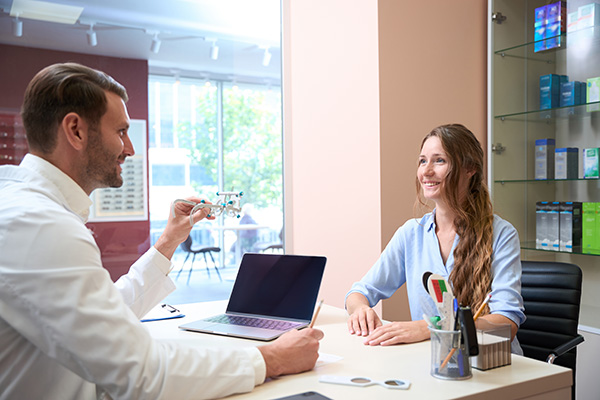
We put all this effort into marketing our business to bring people into our practice. Once they’re there, we want to convert or capture these patients. You’re not going to get everybody, but once you get them, if you are able to convert into a second or third pair, that’s where the greatest profitability is. The best way to get that second or third pair is by offering deeper discounts on that multiple-pair purchase. When you have a lens company that’s not supporting that, that affects your bottom line. If they’re supporting that multi-pair purchase mentality, that’s where the profitability is.
Multi-pair is an important part of the conversation. It is definitely for profitability, for capture rate, and all these things. If you have the customer, the patient, or the client in front of you, you’re making the most of that opportunity by converting multiple pairs. HOYA is helping us do that by giving us these programs behind the scenes. Talk about premium. Multi-pair is an important part of the discussion for revenue and building the practice. You have a beautiful practice. You sell a lot of higher-end frames and that kind of thing, but let’s talk about the ophthalmic lens side. What does selling a premium product do for your patient retention and other ways of building your business?
Overcoming Hesitation In Offering Premium Products Through Education
I’ve always been in the mindset that when patients come to see me as their eye care provider, our job is to do, offer, and give the best recommendations, best products, and best service in every caliber. It’s not our responsibility to be so concerned about their pocketbook, what they can or cannot afford, or what they can or cannot do. That’s one of the biggest downfalls. When I’m sitting there mentoring our colleagues across Canada, I see this. People are hesitant. “They may not be able to want to pay this. They may not afford this. This is not what they want.” Our job is not that.
Our job is truly to offer the best in product and allow them to make decisions. Give them options and let them make the decision. In two different studies, 80% in one study and 76% in the other study of people are willing to pay for better technology or better innovation if they understand why. That’s where the gap is. We need to do a better job of educating why we recommend this best artificial tear, this best glaucoma medication, this better contact lens, or this better ophthalmic progressive lens. If they have that knowledge, the conversion and the capture rate are much higher.
The capture rate is higher. What about as far as retaining the patient or referrals? Do you find that that’s greater when somebody has purchased or invested in a premium product versus something that’s a bit more mainstream?
You tend to see a better return on engagement and the return of patients in that case because they remember that you gave them the best of the best. They walked out of there feeling empowered by what they’ve chosen and the knowledge they have about why it’s better. Their experience proves itself. That’s what you need. You don’t want to just sell something at a premium price, but it doesn’t deliver in the end. That’s the point. We know the lenses that we’re getting are high caliber, are top in class, and are performing out there in our patients.
The Role Of Patient Stories In Marketing & Referrals
You need that faith in the product to do what it’s supposed to do. You can speak to it with confidence. When we make these recommendations, a lot of people, in general, myself included, like to tell stories about the things that we’ve purchased or the experiences we’ve had. When we do purchase something premium, we’re likely to go tell our friends about it. “This lens has got this feature. It’s got this thing. It helps me do that.” When we help people tell those stories, they become advertisements for us to promote ourselves to their friends and their family. There’s some value in that as well.
You said the word right there, value. That’s what we’ve got to key into because in this economic climate, there is more awareness and mindfulness of where we’re putting our dollars and cents. Certain politicians say something, and then the economy changes this much that quickly. Certain public figures say something or do something. All of a sudden, our economy is on the fritz of this and that. At the end of the day, as much as there’s more of an awareness of spending, consumers are still willing to pay for value. That’s what we said. If we can provide value to that patient-centric service with top-quality products, educating them why, and giving them some competitive price or a discount or a promotion, people will pay for that value.
You touched on this already. I want to spend a bit more time chatting with our colleagues about overcoming some of those fears and mental hurdles that we have about speaking or offering premium products, and that type of thing in our practices. You do see a lot of colleagues. You travel. You speak. You see a lot of people in person. You have these conversations because you speak about premium contact lenses or whatever it is. You mentioned that we sit there and sometimes prejudge how much we think the person in front of us might be willing to pay or able to pay. Are you noticing other things or hesitations? What are we so afraid of?
I don’t know. I look at our colleagues in the dental field. They’ve nailed this. They don’t care. They just offer. They tell you what you pay, and they do it. You know they’re taking the best care of you. We have to adopt more of that mindset, that we’ll bring in the best diagnostics and therapeutics. We’re going to recommend what we feel this patient should have. It’s more to that, circling back to what I said a little earlier. As long as we provide education and options, then we’re doing our job. Whether they choose top class, next in class, or bottom class, that’s on them.
They walk away knowing that knowledge. The worst thing that can happen is that we tell them something, they look at the price, and they walk away. They talk to their friend like, “I got this lens. It has next to no reflection. It has no distortion. It was awesome. I had a great experience.” They don’t talk about price. They talk about their experience with it. Let our patients be our spokespeople for our business. Let them market our business based on the value that they have received from our business.
That’s an excellent way of putting it. To go a little bit more granular on the patient experience when your staff are fitting premium progressive or something, do you have a digital way to take measurements? How do they do that? What do you think the value is in that if you do that?
Technology is always great. I’m not saying it always works. We have tried different devices in the past and with varying degrees of success. Things are evolving. The conventional way of measuring with a ruler and eyeballing it with a pen is still a tried, tested, and improved way. We’re seeing advancements in technology with a lot of lens companies, which is nice.
Through our partnership with HOYA, we brought on the OptiCam. We use that iPad. OptiCam is a great product. We use it on a regular basis. In the beginning, it took some training. It took our staff to get used to it. It felt like it took longer. They had to encourage them to get used to it. Now, they’re getting onto it. It’s more streamlined. They understand, “I correct posture,” all this stuff. It helps to provide that premium experience. I get it. Dotting the thing works. We get it right. It fits well. We’re so used to doing it. I get it, but if we’re going to try to elevate that experience a little bit, then it becomes a bit of this patient experience was cool. Staff experience was not so good. How do we make sure both are getting a good experience?
One of the best ways to differentiate your business is through innovation.
Sometimes, changing patterns of behavior in any capacity is difficult, whether it’s with colleagues or within our team. You have to persevere, constantly remind them, and persist in making that change. You’re right. It does work, and it’s a better patient experience.
Going back to experience and having them become our spokespeople, I want them to be able to leave and say, “That’s the first time someone took my measurement that way.” I have to make sure I took it right, that the lens turns out the way it’s supposed to turn.
There’s human error for sure.
Going back to providing value, education is the answer to the term that we’re afraid of, selling or upselling. If we know that we’re coming from the right place, providing the education, and showing the patient the value of the benefit, then it doesn’t feel so much like selling. It’s going to feel authentic. It is ultimately hard. If it doesn’t feel right inside, then it’s probably not going to sound right.
It’s about recommending. You are taking a doctor’s recommendation. You’re customizing a recommendation based on the patient’s lifestyle needs and then providing them education. Education is a powerful tool. If you position and deliver it properly, then it’s not salesy. It becomes informative. Your eye care provider is providing you with information on the best and the greatest in technology, and the best and the greatest for you and your lifestyle needs.
When you have this conviction, feel you’re confident, believe it yourself as you and our colleagues do, and speak that way to the patient, they can feel it. There’s a bit of an energy transfer there, versus timidly, we’re not so sure when we’re making our recommendation. Patients also feel that. They feel awkward about it, too. Authentically feeling goes back to what we were saying earlier with the training, believing in the product, and all of that stuff. The patient senses that from us as well.
It starts to feel too transactional sometimes. It’s like, “Here’s the best. Here’s the good, better, and best. Here’s the price.” We have to start adding value to the patient, so they don’t feel like it’s a transaction so much. They’re getting something that’s going to help improve their life. Do you have anything else you want to add to that?
I always tell patients that there are hundreds of different lens options out there. If we just hone in on progressive lenses, there are hundreds of different lens options. I tell them in our clinic. We have chosen to narrow that field down to what we feel is the best option. We do have our good, better, and best. There’s no doubt about that. It’s providing options, educating, and explaining what the difference is between the three, but also explaining why. I also feel strongly, and I think you and a lot of my colleagues who are in the retail business of optometry do agree with this. You pay for what you get when it comes to progressive lenses.
The Importance Of Product Confidence & Low Non-Adapt Rates For Premium Sales
I could sell somebody a progressive lens for $150 or $180, but I know their experience may not be as optimal. I know their success may not be as optimal. You’re spending more time problem-solving, readjusting, explaining, and coaching a patient on how to adapt your progressive lens. When you have technology that we do, especially with HOYA providing us the latest in innovation, we have that confidence. We’re not walking away. Our non-adapt rates are very low. Our redo rates are very low, which further ratifies that the end experience is great and our confidence in the product is great.
It’s good that you explained that there are so many varieties. I do the same. I’ll say there are hundreds of designs. You can blindly pick one. Maybe it’ll be great for you, but we’ve got to make sure we’re selecting the right lens for you. There are all sorts of analogies you could do, like shoes or cars. I like cars, so I do car analogies. Every car has a steering wheel and four wheels. You can drive it from point A to point B. It’s not just about the brand or a Mercedes versus a Honda. A pickup truck is different than a sports car. It’s different than a minivan.
If you’re going to drive eight people across the country, you’re not going to take a sports car. You’re going to pick a minivan. We’ve got to figure out what you’re doing day to day. What do we need to support you with? We’re going to help you pick the design according to that. Let’s say you want a comfortable vehicle that you can drive day to day, and that helps you. Do you want a Mercedes? We got that. Are we talking more Honda? Let’s put you in that one. People seem to resonate with that conversation a little bit.
I like my cars, so I fully agree with it.
Pavan’s like, “I’ll take the electric Porsche.” I want to ask you a little bit about the handoff situation in your office. Everybody does it differently. Can you describe it a little bit? What do you feel has been successful as far as handoff for the patient that transitioned from the exam room to the optician?
I do talk to a lot of our colleagues about this specific process of the patient journey. It’s imperative in patient education, patient understanding, and then capture and transition into something that may profit your business as well. I don’t feel that there’s a right or wrong, whether the pass off is done in the exam room, in the dispensary, or in the front office. Depending on the setup of your business and what works best for your staff, that’s independent. I haven’t read any studies on which one is favored or the other. That’s personal.
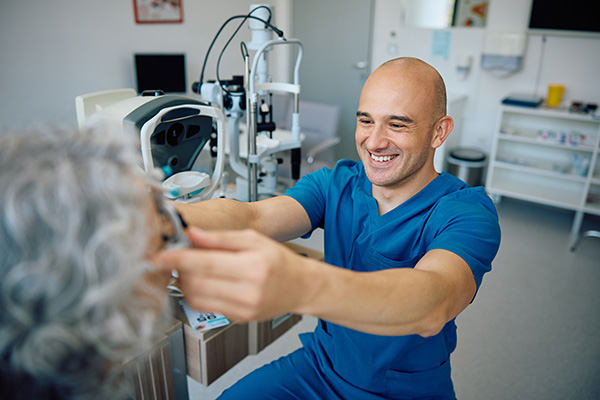
What’s important as a clinician or as a doctor is to do one of two or three things, which is to do a pass-off. You’d be surprised if your colleagues don’t do any type of pass-off. I honestly think just leaving notes in the EMR and letting the staff take off is not sufficient. In our clinic, we go through the formality of having a specialized checklist. It’s a tear-off that we pass off. Some people do like a little rub off things to be a little more environmentally friendly. They are top-line things that you want your staff to deliver on, whether it’s pre-appointing them for their annual exam, ordering them with those trial contact lenses, a specific artificial teardrop you want them to talk about, or a couple of promotions on lenses that you know that’ll be pertinent to what their visual needs are.
The “Three Times” Rule For Effective Patient Handoff & Accountability
In an exam room, they say, and this is something I’ve implemented in my practice for many years, is that you want to repeat your recommendation three times. Remember, the average person comes in for an eye exam every 3.7 years. When they come in and they hear the word stigma or stigmatism, however they want to perceive it, for them, that’s a big deal. They think something is wrong. When they hear you have dry eye, they think something is wrong. We talk about it 15 to 20 times a day, times 300 days a year. It becomes common rhetoric for us.
We have to realize this is something alarming. When presenting a lot of information, “This is a summary of your exam,” a lot of it may not be retained or understood. Repeating it three times allows the high-end points to be remembered by these patients. Whenever I’m going through my exam, be it the refraction as I start it with, I’ll repeat after. “Mrs. Jones, your eyes are doing great. There’s little change in your reading prescription, as I demonstrated. I will recommend that we upgrade your office progressives or get another pair of reading glasses.”
I’ll go on to the anterior segment, and then I’ll recap that. At the end of the exam, I will take it at a higher-level summary point and recap. “Mrs. Jones, it was a great visit. I’m so glad that we saw you today. We are going to see you in two years. I don’t need to see you sooner because your eyes are doing so great. As we talked about, I’d recommend updating those reading glasses and that artificial tear for that intermittent dryness that you’re talking about.”
You’re recapping that again. The third time is when you officially do that pass-off. I’m writing on a little sticky note to my staff, which holds them accountable. If they get busy, they can circle back to that. You’re reminding the patient in front of the staff of what they need to do. It creates a little bit more formality in allowing them to deliver on our recommendations.
That’s amazing advice. I appreciate that insight about the three times. I’m trying to think as you were talking, I was like, “I am pretty sure I got two times down. I think I got three.”
Get up your game, buddy. Knowing this, my year should be like, “I do it four times.”
I’m going to give them even before the exam starts. I’m going to tell them what they need, in the middle, then at the end. Now that I’m thinking about it, I have similar timing as you when I finish the refraction. Sometimes, I go into a bit too much detail after the refraction. The patient thinks the exam’s done because I’m like, “Just wrapping that up.” They’re like, “Cool. Am I done?” “No. Hang on. Let’s do the health side of things.” I will have a recap at the end of the exam. When I go outside and I’m passing it off to the optician, it’s important for the patient to hear us telling somebody else. They know, “This person also knows what we’re talking about.”
It creates accountability.
That’s a good word. It’s good to hear. I appreciate you putting it that way. That’s going to help many of our colleagues out there to streamline that process a little bit. We talked about a lot of stuff. We talked about how you built your business and some of the key factors there. I’m going to go back and try to remember that. Correct me if I’m wrong. Culture, differentiation, and patient-centric. It is very important. We talked about how premium products, premium lenses, have been a big part of the growth of your practice. Did we miss anything we think we needed to share that we haven’t shared yet?
No. We’ve covered a lot. You and I can probably go off on a tangent and talk about anything and everything for the next little while. We’re very fortunate to have some great industry partners in our profession. It’s important to leverage your relationship with whether it’s the rep or them as a whole, because they are willing to support your growth a lot. Whether it’s a frame company, a lens company, a contact lens company, or artificial gear, it’s in their best interest to see you grow. By leveraging what they are willing to offer you and support you, like HOYA does for our business, it’s allowed us to better service our patients, better grow our business, keep our staff more educated, and improve team culture by knowing what they’re talking about.
That’s such an important note for us to mention. I say this when I give a lecture on myopia management or dry eye. At the end of the thing, I’ll talk about, “Here are some steps that I would recommend to start this in your practice.” One of the last things I always say is to make sure you develop that relationship with your reps and industry partners. I always joke that I used to hide from my reps.
I still hide from a couple of them.
I say this generally, and then people are like, “All of them?” No. I say, “I used to hide from them, and now, I hug them.” There are a few that we still don’t hug. The point is that I am fond of those relationships. They’ve been valuable for us to grow our practice. That’s been amazing. There’s a question that I’d like to ask on the show that I’ve been doing a bit more consistently. I didn’t prime you for this, but I’ll give you some time to think about it.
Sometimes changing patterns of behavior is difficult, whether it’s with colleagues or with a nerd team. You have to persevere, keep reminding them, and persist in making that change—and eventually, they will.
Thank you.
Do you have young boys?
Yes.
Do they watch Disney movies?
No, we’ve moved on from that.
Have they seen Moana? Have you seen Moana?
Yes, I have. They have two.
In the first one, there’s a character. He’s in both movies. His name is Maui. Dwayne Johnson plays that character. He’s got a song in the first movie that’s called You’re Welcome. I have all my guests sing that song. I’m just kidding. The point of that song is he’s egotistical, and he’s like, “You’re welcome. I give you all these nice things.” This is your opportunity to share one powerful, impactful thing, whether it’s a quote or a piece of advice.
I know you shared a lot of good stuff already. What is the one thing that you think has maybe changed your life that might change somebody else’s? I’ll give you time to think about it. When you’re done, I’m going to say, “Thank you.” You’re going to say, “You’re welcome.” We’re going to do You’re Welcome. If you got it, you can take the second. What’s one thing that you want to share that you think could help improve our lives?
We all have busy lives. I don’t think mine is any busier than the others with kids, life, social, and running the businesses. It’s very important, every now and then, to stop and smell the roses. It’s good for mental health, physical health, and emotional health. It allows you to be a better person, a better friend, a better father, and a better practitioner as well.
It’s amazing. Thank you.
You’re welcome.
When you say stop and smell the roses, what does that mean for you? Is it certain activities, taking a vacation, or what kind of stuff?
It could be anything. I’m just stopping in the middle of that bridge that you’re hiking in the middle of the day to get a good workout. Look around and observe where you’re at. Pause wherever you’re at in that chaos of the day and say, “There is so much to be grateful for. Everything is good.” Even if there may be stress involved, you’ve got this. To be running around the kids from activity to activity, stopping, and watching them in their chaos and their happiness, you realize the beauty and the innocence of who they are. It’s about stopping in your business and looking at, “This is what you’ve created after 22 years.” It’s stopping to smell the roses.
I love that. That’s amazing. That’s beautiful. That’s the best way. We’re going to keep that as the end of the show. Thank you. I appreciate it for always coming on and supporting the show. Thank you to HOYA Vision Care Canada for supporting the show, the profession, and our clinic. I am always grateful for everything they do. Thank you to everybody who’s reading this episode. This is Canada’s number one optometry show. We’ll see you guys in the next episode. This guy gives the best hugs, too.
Important Links
- Dr. Pavan Avinashi’s Website
- Hollyburn Eye Clinic
- HOYA Vision Care
- HOYA Vision Products
- BC Doctors of Optometry
About Dr. Pavan Avinashi
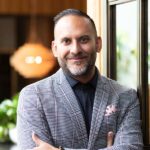 Upon completing his Doctor of Optometry from the Illinois College of Optometry in Chicago, Dr. Avinashi spent time travelling, performing clinical electives around the world. These experiences, as well as his fluency in English, French, and Hindi, have allowed him to better connect with patients and develop his scope of practice to specialize in pediatric care and ocular surface conditions – most notably dry eye disease.
Upon completing his Doctor of Optometry from the Illinois College of Optometry in Chicago, Dr. Avinashi spent time travelling, performing clinical electives around the world. These experiences, as well as his fluency in English, French, and Hindi, have allowed him to better connect with patients and develop his scope of practice to specialize in pediatric care and ocular surface conditions – most notably dry eye disease.
Outside of his clinical commitment, he takes a strong interest in serving the global community and has initiated various fundraisers to promote ocular health in developing countries. Dr. Avinashi is a notable lecturer at schools, local senior homes, and medical conferences across the country, focusing on ocular diseases and technological advancements in optometry.
In 2013, Dr. Avinashi was honoured to be recognized by the BC Association of Optometrists as the Young Optometrist of the Year, and in 2014, the North Vancouver Chamber of Commerce acknowledged him as the Young Entrepreneur of the Year.
